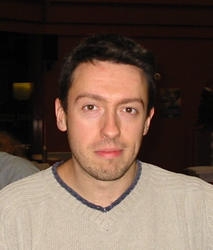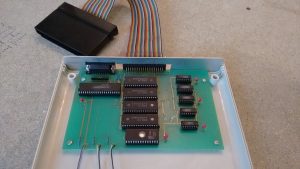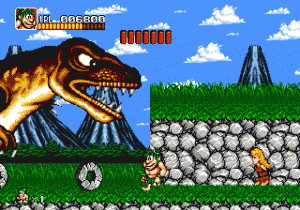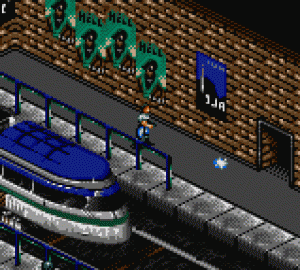 Few western developers were as diverse during the Genesis era as Stuart Middleton. Through his company, Eden Entertainment, he programmed and created tools for the Master System, Genesis, and Game Gear; and the label released quality arcade conversions and new properties – all with fewer than 15 people in the entire company. Honing his skills on the Sinclair ZX Spectrum for companies like Elite Systems and Virgin/Mastertronic, Middleton achieved enough success to found his own company.
Few western developers were as diverse during the Genesis era as Stuart Middleton. Through his company, Eden Entertainment, he programmed and created tools for the Master System, Genesis, and Game Gear; and the label released quality arcade conversions and new properties – all with fewer than 15 people in the entire company. Honing his skills on the Sinclair ZX Spectrum for companies like Elite Systems and Virgin/Mastertronic, Middleton achieved enough success to found his own company.
As one of the founders of Eden, Middleton worked on many different Sega platforms. His work on Joe & Mac on the Genesis produced a very faithful and enjoyable port, and Eden’s Game Gear exclusive Arena: Maze of Death provided a beautiful and engaging isometric action experience. The company was also behind the unreleased, side-scrolling Dragon’s Lair action game that was dumped and is now playable to Genesis owners with flash carts and repro skills everywhere.
With over 30 years in the gaming industry, Middleton has established himself as a reliable and talented programmer. He’s also provided Sega fans with some very enjoyable titles, shipping almost a dozen while with Eden.
Sega-16 recently spoke to Mr. Middleton about his experiences working on Sega’s 8 and 16-bit platforms.
Sega-16: You were one of the co-founders of Eden Entertainment Software. How did the company start?
Stuart Middleton: My business partner Tim and I met while working at Arc Developments. Tim was working there as an Atari ST programmer when I joined to write PC conversions. After a couple of years of writing home computer games, we wanted to branch out into console games. I made some hardware which enabled us to write Master System and Genesis games, and Tim and I figured out the hardware by disassembling the game code of a few titles. We approached a few companies about freelance work and told them we had Mega Drive and Genesis experience. Probe gave us an offer to write Alien 3, so we both quit our jobs and set up in an office above a video shop owned by a friend of mine. We worked as a two man team for a while on several projects before getting contracts big enough to hire more people. We employed 14 people at one point before having a contract cancelled on us by Sega, so we had to make everyone redundant.

Sega-16: You also reverse-engineered Sega hardware to create development systems. Was this for Sega itself? Which machines did you reverse-engineer?
Stuart Middleton: We wanted to get into Sega development, but we weren’t in the position to work for them directly. I initially reverse-engineered the Master System for fun. I was primarily a Z80 guy, so this was the easiest choice for me. I initially made a ROM emulation system and figured out the hardware from disassembling the game code from a couple of games. This later developed into a complete system which allowed us to build the project on a PC and download it to the Master System at the same time. It also supported debugging and other features.
With the Genesis, I jumped straight into a system that allowed you to download projects real-time. Tim mainly did the code analysis on the Genesis with me designing and building the hardware. Before I completed the Genesis system, we started working on Alien 3. At the time the only systems available to write for Master System and Genesis used either ROM emulators, which were slow and didn’t support debugging, or the SNASM system which was well designed but required the removal of the CPU from the Genesis and was out of our price range, so we were pretty happy with the systems we created.
Sega-16: Many versions of Alien 3 list you as providing “technical support,” and the game was designed by Probe Software. However, Eden programmer Tim Round worked on the Genesis version. What was Eden’s role, exactly?
Stuart Middleton: Tim and I initially started work on it, but Tim ended up doing most of the work while I took on other projects at Eden. We were just starting out, and were trying to do as much as possible to get the company off the ground. In fact, I don’t think we were even called Eden software at the time, we were just working as freelance programmers together. I’m not sure where the “technical support” credit came from, but that’s quite accurate. I mostly wrote tools for that game, along with the sound system, but very little or no actual game code.
Sega-16: After Alien 3, Joe & Mac was your next project for the Genesis, correct? How did you find the hardware compared to the computers you previously worked on, like the Spectrum and the Amiga?
Stuart Middleton: Alien 3 was the first Genesis game I worked on, although Tim did most of the work on that project. My work on Joe & Mac was mainly to do with the graphics code for the scrolling backgrounds and the sprite layout as well as working on the sound system using the co-processor. Because I’d reverse engineered the hardware previously, I was intimately aware of the hardware. Coming from a Spectrum background, the Genesis was the most advanced platform I’d worked on; however, we always pushed any machine we worked on, and the Genesis was no exception. We had to come up with some interesting techniques in order to convert Joe & Mac to the Genesis.
Sega-16: The Genesis port of Joe & Mac was very close to the arcade original, only really lacking in color detail (which subsequent hacks have fixed). Was there ever any temptation or desire to add more to the game, or did Eden set out to create only a faithful arcade port?
Stuart Middleton: We felt we made a faithful copy of the arcade original. We actually took the graphics from the arcade machine and converted them directly for the conversion. The Genesis didn’t have enough memory to contain the levels, so we came up with a process where we could copy across new background graphics on the fly so that we could get everything in. The sprites were more of a challenge, but Tim worked really hard to faithfully reproduce the game with the limitations of the Genesis compared to the original arcade machine. We did have to cut back in some areas, but I think they were few and far between. I wasn’t aware that there were hacks to fix the color problems. I’d be very interested in knowing what they were and where we went wrong.
 Sega-16: A sequel to the game was released for the Super NES and in arcades. Was Eden ever contacted about doing one, or was the original game a one-shot deal?
Sega-16: A sequel to the game was released for the Super NES and in arcades. Was Eden ever contacted about doing one, or was the original game a one-shot deal?
Stuart Middleton: This was just a one-of project. At Eden we mainly did work for hire, and we were only offered this project.
Sega-16: Arena: Maze of Death on the Game Gear is a pretty unique title on the game gear. How did the idea to develop it come about?
Stuart Middleton: If I remember right, the idea came from myself and one of our employees Jason Evans. I don’t remember what sparked the original idea, but it was probably based on what we were playing at the time (I’ve asked Jase if he remembers).
Sega-16: Was it difficult to create an isometric action game on the Game Gear? Did the hardware present any particular difficulties?
Stuart Middleton: I do remember having issues with the isometric view. The obvious character mapped graphics of the Master System make an isometric views difficult. One of our artists, Jason Evans, came up with some great ideas on how to overcome these problems. We built walls from repeating sections and used the art style of leaving sections out of the walls and floors to reduce the need to join sections together. We had the game working on Game Gear and Master System, but they only wanted the Game Gear version. Sega were very happy with the results, and we were very proud of what we accomplished.
Sega-16: The game’s graphics are incredible for an 8-bit portable title. How did you achieve a level of visuals that rivals even some Genesis games?
Stuart Middleton: Our lead artist, Rob Dorney, modeled the characters in 3D and output each frame required as an image. He then went over the in DPaint and cleaned them up for use as sprites. The backgrounds were all done by Jason.
Jason had this to say about it: “We designed our own level editor for the game. The 2×1 isometric nature of the graphics required us to have foreground and background layers so that we could have the player move behind things. The first level in the warehouse had stacks of crates which we wanted the player to walk behind. We used this technique a lot through the levels. Overhead pipes used the same method and gave the illusion the player was walking underneath them. That is, if they avoided the steam. Our in-house level editor was used to place all the puzzles, place enemies, and background graphics and handle all the collision. We could choose which direction sprites were facing, place ammo , health, link switches to doors as well as keys etc, we used same system for teleporters. The 8-bit limitations of the Game Gear meant we had to be very smart about the colors we used in our 8×8 tiles.”
 Sega-16: Were there any plans for a sequel to Arena? Who owns the rights to the game now?
Sega-16: Were there any plans for a sequel to Arena? Who owns the rights to the game now?
Stuart Middleton: I have no idea about the rights; I guess they stayed with Sega. The company folded shortly after Arena, so there was never any chance of a sequel. I have no idea how well it sold, but I do remember there were some great reviews, so a sequel would have been something Sega would have wanted.
Sega-16: Were there any Sega-related projects you were working on that were never completed?
Stuart Middleton: We did write a few Genesis prototypes for a few companies over the years that never got released. I remember a sideways platform game based on the Dragon’s Lair laser disc game, for instance. We even wrote a full game based on the cartoon Wacky Races that didn’t make it to the stores. I think that one has since been released from the programmer who worked on it for us.
Our thanks to Mr. Middleton for sharing his memories with us!

Recent Comments